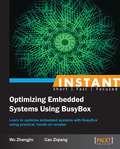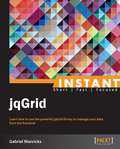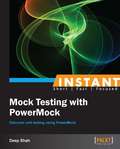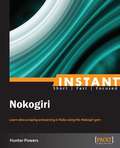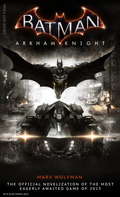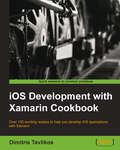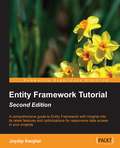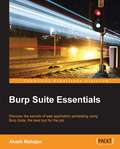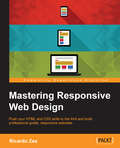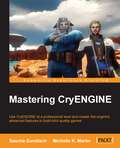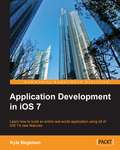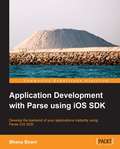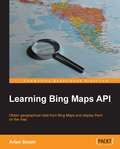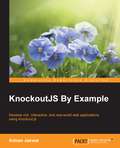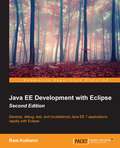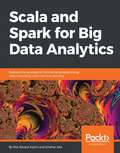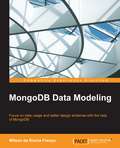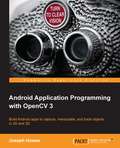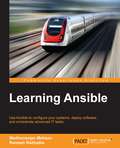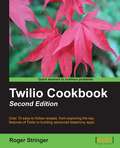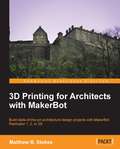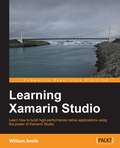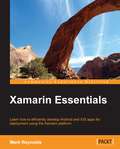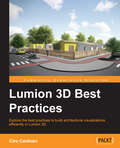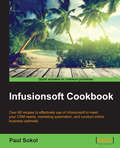- Table View
- List View
Instant Optimizing Embedded Systems using Busybox
by Wu Zhangjin Cao ZiqiangFilled with practical, step-by-step instructions and clear explanations for the most important and useful tasks. A step-by-step guide which provides concise and clear recipes for getting started with Busybox.If you are an embedded system developer or Android developer who wishes to learn to build an embedded (Android Linux) system from scratch, as well as to optimize the system performance, then this book will be great for you. It's assumed that you have some experience in Linux and UNIX utilities. If you are a new developer, this book will also help you to get started with Busybox and Android Linux development.
Instant jqGrid
by Gabriel ManricksGet to grips with a new technology, understand what it is and what it can do for you, and then get to work with the most important features and tasks. A step-by-step, practical Starter book, Instant jqGrid embraces you while you take your first steps, and introduces you to the content in an easy-to-follow order.This book is aimed at people who have some knowledge of HTML and JavaScript. Knowledge of PHP and SQL would also prove to be beneficial. No prior knowledge of jqGrid is expected.
Instant Mock Testing with PowerMock
by Deep ShahFilled with practical, step-by-step instructions and clear explanations for the most important and useful tasks. A concise guide full of step-by-step recipes, to teach you how you can use PowerMock to unit test code.If you are a beginner who would like to learn how to use PowerMock, this is the perfect guide for you! As the book comprehensively covers both basic and advanced concepts, this guide is also suitable for those of you who have an intermediate knowledge of PowerMock.
Instant Nokogiri
by Hunter PowersGet to grips with a new technology, understand what it is and what it can do for you, and then get to work with the most important features and tasks. A concise, illustrated guide to extracting information available on the Internet using Nokogiri."Instant Nokogiri" is the perfect choice for the aspiring Ruby developer looking to incorporate screen scraping and parsing technology in their applications. Beginner level Ruby, basic HTML, and CSS experience is suggested.
Batman Arkham Knight: The Official Novelization
by Marv WolfmanGotham City is in chaos as the criminal organizations run wild, seeking to fill the void left by the death of the Joker. When the Scarecrow threatens to unleash a toxin that will kill scores of innocents, the result is uncontrollable panic.TM & (c) DC Comics. (s15)
iOS Development with Xamarin Cookbook
by Dimitris TavlikosThe book is written in a recipe format with practical examples, allowing you to go directly to your topic of interest or follow topics throughout a chapter to gain an in-depth knowledge. There are also plenty of hints and best practices along the way. If you are a C#/.NET developer with no previous experience in iOS development or an Objective-C developer who wants to create complete iOS applications and deploy them to the App Store, then this book is ideal for you. No experience with Xamarin is needed.
Entity Framework Tutorial - Second Edition
by Joydip KanjilalA comprehensive guide to the Entity Framework with insight into its latest features and optimizations for responsive data access in your projects About This Book * Create Entity data models from your database and use them in your applications * Learn about the Entity Client data provider and write statements in Entity SQL to perform CRUD operations * Explore ADO.NET Data Services and how they work with the Entity Framework Who This Book Is For If you are a C# developer who wants to learn a new way of querying data and utilizing it in applications efficiently for data binding or other operations, then this book is for you. Basic knowledge of ADO.NET is assumed. What You Will Learn * Explore the features of the ADO.NET Entity Framework * Understand the concepts of entities and their relationships * Create an Entity Data Model using the ADO.NET Entity Data Model Designer and the EdmGen tool * Extend existing Entity Types to create your own Entity Types * Write programs against the Entity Data Model to perform CRUD operations * Discover ADO.NET Data Services and learn how they can be used with the Entity Framework * Familiarize yourself with WCF Data Services (formerly ADO.NET Data Services) * Apply Code First, Model First and Database First approaches In Detail The ADO.NET Entity Framework from Microsoft is a new ADO.NET development framework that provides a level of abstraction for data access strategies and solves the impedance mismatch issues that exist between different data models. This book explores Microsoft's Entity Framework and explains how it can used to build enterprise level applications. It will also teach you how you can work with RESTful Services and Google's Protocol Buffers with Entity Framework and WCF. You will explore how to use Entity Framework with ASP.NET Web API and also how to consume the data exposed by Entity Framework from client applications of varying types, i.e., ASP.NET MVC, WPF and Silverlight. You will familiarize yourself with the new features and improvements introduced in Entity Framework including enhanced POCO support, template-based code generation, tooling consolidation and connection resiliency. By the end of the book, you will be able to successfully extend the new functionalities of Entity framework into your project. Style and approach This book is a step-by-step tutorial providing hands-on code examples with detailed explanations. The book aims to explain the concepts of the Entity Framework and illustrate how you can use these in applications with a tutorial based approach.
Burp Suite Essentials
by Akash MahajanIf you are interested in learning how to test web applications and the web part of mobile applications using Burp, then this is the book for you. It is specifically designed to meet your needs if you have basic experience in using Burp and are now aiming to become a professional Burp user.
Mastering Responsive Web Design with HTML5 and CSS3
by Ricardo ZeaBecome a master in RWD with this practical, engaging guide About This Book * Build responsive designs with solid yet simple HTML5 and CSS3 best practices * Use CSS preprocessors (Sass) to speed up the creation of CSS * Each chapter covers a different feature of RWD with carefully chosen, interesting examples, including the latest developments in responsive design Who This Book Is For If you already know some HTML and CSS and understand the principles of responsive web design, this book is for you. There's something here for you to learn regardless of if you're a web designer or web developer, or whether you're a seasoned expert web professional. What You Will Learn * Install and use Sass with SCSS syntax to create your CSS * Use HTML5 tags the right way for the right type of content * Enhance the experience of users with assistive technology with ARIA roles * Design with desktop-first approach but implement with mobile-first methodology * For your layouts, either create and use your own scalable CSS grid, or use Flexbox * Create three types of navigation for small screen devices * Find the best way to serve the best type of image and how to make videos responsive * Build custom responsive emails to ensure the message gets across regardless of the device In Detail Responsive web design is getting more complex day by day and without the necessary design and development skill sets, it's a matter of time before we're left behind. Building meaningful and accessible websites and apps using HTML5 and CSS3 is a must if we want to create memorable experiences for the users. In the ever-changing world of web designers and developers, being proficient in responsive web design is no longer an option, it is mandatory. Whether you're a web designer or web developer, or a seasoned expert web professional, this book will bolster your HTML and CSS skills to a master level. The book is designed in a way that each chapter will take you one step closer to becoming an expert in RWD. The book begins with introducing you to the power of CSS preprocessors, Sass in this case, to increase the speed of writing repetitive CSS tasks, then use simple but meaningful HTML examples; and add ARIA roles to increase accessibility. You will also understand why a mobile-first approach is ideal. Next, you will learn how to use an easily scalable CSS grid or if you prefer, use Flexbox instead. Create navigations for small screen devices using the "drawer navigation," "off-canvas" or "toggle" navigation patterns, and also implement images and media in both responsive and responsible ways. Finally, you will build a solid and meaningful typographic scale and make sure your messages and communications display correctly with responsive emails. Style and approach Designing and developing for the web should be fun, and that's the tone used in the book. This book is written in a step-by-step format with clean-cut examples. You will also find tips and notes all over the book to help clarify those small and simple details most books and tutorials assume you already know.
Mastering CryENGINE
by Sascha Gundlach Michelle K. MartinA comprehensive guide that covers advanced tasks performed with the CryENGINE system using interesting examples and illustrations demonstrating each of its features. This book is designed for developers who already have a basic understanding of CryENGINE and who want to take their skills to the next level. Whether you are a hobbyist developer or you are working on an AAA project, Mastering CryENGINE will help you enhance your CryENGINE proficiency.
Application Development in iOS 7
by Kyle BegemanA hybrid between informative overview and step-by-step instruction, this book is the ultimate guide to iOS 7 application development. If you are an iOS developer who is looking to understand the new features within iOS 7 and Xcode 5, then this book is for you. In order to fully understand the concepts in this book, it is recommended you have at least some experience with previous versions of iOS.
Application Development with Parse using iOS SDK
by Bhanu BiraniA practical guide, featuring step-by-step instructions showing you how to use Parse iOS, and handle your data on cloud.If you are a developer who wants to build your applications instantly using Parse iOS as a back end application development, this book is ideal for you. This book will help you to understand Parse, featuring examples to help you get familiar with the concepts of Parse iOS.
Learning Bing Maps API
by Artan SinaniThis is a practical, hands-on guide with illustrative examples, which will help you explore the vast universe of Bing maps.If you are a developer who wants to learn how to exploit the numerous features of Bing Maps then this book is ideal for you. It can also be useful for more experienced developers who wish to explore other areas of the APIs. It is assumed that you have some knowledge of JavaScript, HTML, and CSS. For some chapters a working knowledge of .Net and Visual Studio is also needed.
KnockoutJS by Example
by Adnan JaswalDevelop rich, interactive, and real-world web applications using knockout.js About This Book * Master the full range of features provided by knockout.js such as declarative binding, automatic refresh, dependency tracking, and templating using this project based guide * Tackle real-world problems such as page navigation, forms, composite UI components, maps integration, server interaction for CRUD operations, and application security * Discover the power of knockout.js as you build applications with complexity ranging from beginner to advanced * Extend and customize knockout.js to harness its full potential * Integrate with third party libraries and APIs to build fully featured applications Who This Book Is For This book is intended for designers and developers who want to learn how to use Knockout to develop rich, interactive, and modular web applications. The book assumes no prior knowledge of the Knockout library but basic familiarity with HTML, CSS, and JavaScript would be helpful. What You Will Learn * Explore the basic concept behind the Model-View-View Model (MVVM) design pattern and how it is implemented by Knockout * Develop a modular application skeleton based on the module pattern that can be used as a template for your projects * Create single page, rich, interactive, modular, real-world applications using Knockout * Use knockout.js with other libraries and APIs such as JQuery, Bootstrap, and Google Maps API to give your users a richer experience * Create a real-world dynamic web form to capture user information and learn how Knockout makes it easier to capture, validate, and submit form data * Develop and use dynamic UI components such as grids, tabs, dialogs, and wizards * Extend knockout.js to add custom extenders, binding handlers, and observables * Communicate with the backend server using JSON over restful web services * Secure your single page application using token-based authentication In Detail Knockout is an open source JavaScript library that lets you develop rich, interactive, and modular web applications. It reduces the complexities of JavaScript and HTML development by following the Model-View-View Model (MVVM) design pattern. It allows you to efficiently develop highly scalable, testable, and maintainable web applications that are rich and interactive. Knockout is a pure JavaScript library and supports all major browsers. This book starts with introducing the key features and concepts of knockout.js. It helps you create an application skeleton and a hello world application. You will develop a To-Do list application that aims to show the basic features of knockout.js in action such as data binding and observables, following which you will develop a dynamic online customer registration form that captures and validates customer information. This book will further walk your way to develop a customer banking portal, which demonstrates the use of knockout.js with components such as navigation bars, tabs, carousel, master details view, panels, forms, wizards, and modal dialogs. You will also discover to use token-based authentication and authorization to secure the customer banking portal and move on to creating an editable products grid with CRUD operations. Finally, you will explore using the Google maps api with knockout.js. By working along with the examples, this book will not only leave you with the basic understanding of knockout.js fundamentals but you will also have a web application ready instantly. Style and approach The book takes an iterative approach in explaining and building the sample applications. The applications are built in small portions with each portion delivering a set of features. It is an easy-to-follow yet comprehensive hands-on guide, which is full of real-world applications.
Java EE Development with Eclipse - Second Edition
by Ram KulkarniDevelop, debug, test, and troubleshoot Java EE 7 applications rapidly with Eclipse About This Book * Go beyond simply learning Java EE APIs and explore the complete workflow of developing enterprise Java applications * Learn to use the features of Eclipse JEE to simplify Java EE application development * Develop and deploy complete applications with JEE Who This Book Is For If you are a Java developer who has little or no experience in JEE application development or you have experience in JEE technology but are looking for tips to simplify and accelerate your development process, then this book is for you. What You Will Learn * Set up Eclipse, Tomcat, and Glassfish server for JEE application development * Use JSP, Servlet, JSF, and EJBs to create a user interface and write business logic * Create JEE database applications using JDBC and JPA * Handle asynchronous messages using MDBs for better scalability * Deploy and debug JEE applications and create SOAP and REST web services * Write unit tests and calculate code coverage * Troubleshoot application performance and memory issues In Detail Java EE is a technology for developing enterprise class, scalable applications. With recent changes to Java EE specifications, JEE application development has become a lot simpler. However, recent changes have also added many new specifications, some of which compete with existing JEE specification. Along with JEE specifications and APIs, it is also very important to understand the entire application development process and tools that can help simplify and accelerate JEE application development. This guide provides a complete overview of developing JEE applications using Eclipse. The many features of the Eclipse IDE are explained. These enable the rapid development, debugging, testing, and deployment of JEE applications. You'll explore not just different JEE technologies and how to use them (JSP, JSF, JPA, JDBC, EJB, web services etc.), but also suitable technologies for different scenarios. The book starts with how to set up the development environment for JEE applications and then goes on to describe many JEE specifications in detail, with an emphasis on examples. You'll learn how to deploy an example application on Tomcat and Glassfish Application Server. You'll create a simple application that reads from a queue, processes the request, and publishes results to a topic and Eclipse MAT (Memory Analysis Tool) to debug memory issues. Style and approach This guide takes a step-by-step approach to developing, testing, debugging, and troubleshooting JEE applications, complete with examples and tips.
Scala and Spark for Big Data Analytics
by Md. Rezaul Karim Sridhar AllaHarness the power of Scala to program Spark and analyze tonnes of data in the blink of an eye! About This Book • Learn Scala's sophisticated type system that combines Functional Programming and object-oriented concepts • Work on a wide array of applications, from simple batch jobs to stream processing and machine learning • Explore the most common as well as some complex use-cases to perform large-scale data analysis with Spark Who This Book Is For Anyone who wishes to learn how to perform data analysis by harnessing the power of Spark will find this book extremely useful. No knowledge of Spark or Scala is assumed, although prior programming experience (especially with other JVM languages) will be useful to pick up concepts quicker. What You Will Learn • Understand object-oriented & functional programming concepts of Scala • In-depth understanding of Scala collection APIs • Work with RDD and DataFrame to learn Spark's core abstractions • Analysing structured and unstructured data using SparkSQL and GraphX • Scalable and fault-tolerant streaming application development using Spark structured streaming • Learn machine-learning best practices for classification, regression, dimensionality reduction, and recommendation system to build predictive models with widely used algorithms in Spark MLlib & ML • Build clustering models to cluster a vast amount of data • Understand tuning, debugging, and monitoring Spark applications • Deploy Spark applications on real clusters in Standalone, Mesos, and YARN In Detail Scala has been observing wide adoption over the past few years, especially in the field of data science and analytics. Spark, built on Scala, has gained a lot of recognition and is being used widely in productions. Thus, if you want to leverage the power of Scala and Spark to make sense of big data, this book is for you. The first part introduces you to Scala, helping you understand the object-oriented and functional programming concepts needed for Spark application development. It then moves on to Spark to cover the basic abstractions using RDD and DataFrame. This will help you develop scalable and fault-tolerant streaming applications by analyzing structured and unstructured data using SparkSQL, GraphX, and Spark structured streaming. Finally, the book moves on to some advanced topics, such as monitoring, configuration, debugging, testing, and deployment. You will also learn how to develop Spark applications using SparkR and PySpark APIs, interactive data analytics using Zeppelin, and in-memory data processing with Alluxio. By the end of this book, you will have a thorough understanding of Spark, and you will be able to perform full-stack data analytics with a feel that no amount of data is too big. Style and approach Filled with practical examples and use cases, this book will hot only help you get up and running with Spark, but will also take you farther down the road to becoming a data scientist.
MongoDB Data Modeling
by Wilson da Rocha FrançaThis book covers the basic concepts in data modeling and also provides you with the tools to design better schemas. With a focus on data usage, this book will cover how queries and indexes can influence the way we design schemas, with thorough examples and detailed code. The book begins with a brief discussion of data models, drawing a parallel between relational databases, NoSQL, and consequently MongoDB. Next, the book explains the most basic MongoDB concepts, such as read and write operations, indexing, and how to design schemas by knowing how applications will use the data. Finally, we will talk about best practices that will help you optimize and manage your database, presenting you with a real-life example of data modeling on a real-time logging analytics application.
Android Application Programming with OpenCV
by Joseph HowseA step-by-step tutorial to help you master computer vision and mobile app development.This book is for Java developers who are new to computer vision and who would like to learn about how it is used in relation to application development. It is assumed that you have previous experience in Java, but not necessarily Android. A basic understanding of image data (for example pixels and color channels) would be helpful too. You are expected to have a mobile device running Android 2.2 (Froyo) or greater and it must have a camera.
Learning Ansible
by Ramesh Raithatha Madhurranjan MohaanIf you want to learn how to use Ansible to automate an infrastructure, either from scratch or to augment your current tooling with Ansible, then this is the book for you. It has plenty of practical examples to help you get to grips with Ansible.
Twilio Cookbook: Second Edition
by Roger StringerThis book is a practical, hands-on guide that provides the reader with a number of clear, step-by-step bite-size recipes. If you are a developer and want to learn about integrating Twilio's API into your websites for telephone solutions, then this book is for you. Basic knowledge of PHP and MySQL is expected.
3D Printing for Architects with MakerBot
by Matthew B. StokesThis is a hands-on tutorial for a user to become well-versed with 3D printing using MakerBots."3D Printing for Architects with MakerBot" is ideal for architects looking to creating stunning prototypes using the MakerBot Replicator 2X 3D printer. Having experience using 3D CAD software is beneficial but not necessary as this book mentions several different CAD packages for beginners, up to those more advanced users who are perhaps looking for additional features.
Learning Xamarin Studio
by William SmithThis book is intended for .NET developers with any level of experience and who are interested in building native applications without the hassle of becoming Objective-C or Java experts. Although it will be beneficial to have some development experience, particularly in .NET, Learning Xamarin help even a novice developer get past the headaches of setting up and customizing their new development environment so they can move on to producing high-quality native applications quickly.
Xamarin Essentials
by Mark ReynoldsIf you are an experienced iOS and Android developer and have a desire to learn about the Xamarin platform, then you will find this tutorial to be the most efficient, interesting, and relevant path. You will find this guide to be especially useful if you wish to become proficient in creating apps using the Xamarin platform, as Xamarin Essentials teaches you the fundamentals of iOS and Android development.
Lumion 3D Best Practices
by Ciro CardosoThis book is designed for advanced Lumion users who wish to apply these techniques to their own projects. The reader should be familiar with modeling knowledge and have at least a basic knowledge of a graphics editing program, such as Photoshop or Gimp.
Infusionsoft Cookbook
by Paul SokolOver 88 recipes for effective use of Infusionsoft to mitigate your CRM needs, marketing automation, conducting online business optimallyAbout This BookMaximize client engagement by automating lead capture and follow-upCollect information and set up lead scoring in Infusionsoft to enhance your marketing interactions to build more clientsSet up online shopping carts, manage your online store, and enhance user experienceWho This Book Is ForIf you want to excel in the use of Infusionsoft to develop a set of common applications or project types and solutions effectively, this book is perfect for you. This book will empower you to provide better results for your clients, faster! It is assumed that you are familiar with and use Infusionsoft.What You Will LearnSet up and configure features that will enhance new user creation using InfusionsoftAttract leads and build your list efficientlyUnderstand the different strategies to sell and get paidCreate amazing customer experiences by following up and automating messagesMaster techniques to use Infusionsoft for internal administrative functionsMake better business decisions by mastering the reporting functionalitySave time and simplifying day-to-day usage using InfusionsoftGet to know the Ninja hacks while working with Infusionsoft efficiently.In DetailInfusionsoft is an all-in-one software-as-a-service (SaaS) for small business sales and marketing. It empowers businesses with the same level of automation and personalization that were previously only available to large corporate enterprises with deep pockets. You can easily manage customer relationships, target communications in an automated manner, and sell their products/services online effectively.Starting with recipes on the general setup and core competencies related to Infusionsoft, you will then learn about tools to enhance user experience. Further on, you'll dive deep into different strategies to attract, sell, and wow your customers.You'll also explore different ways to manage administrative tasks and reporting, which are crucial to perform better workflow management. Later, you will become proficient in lead generation and lead management, referral management, report generation, and working with the campaign builder.Finally, the book closes with unsupported ninja hacks to take your business strategies into the stratosphere!Style and approachA recipe-based guide that covers real-life scenarios on optimising marketing automation, lifecycle management, lead generation, inventory management, and adding ecommerce functionality
